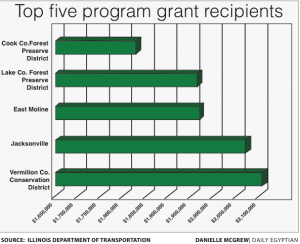State grant to fund transportation improvements

February 5, 2013
A recent state grant could call for celebration among Carbondale bicyclists and walkers.
Governor Pat Quinn said Jan. 30 that select Illinois cities will receive a portion of $50 million from the Illinois Transportation Enhancement Program for community transportation projects, according to an ITEP release. The funding is generally provided every two years, but this year marks the first time the money will be distributed annually, said Paris Ervin, an Illinois Department of Transportation employee.
Carbondale will receive $329,950, according to the release, as well as a portion of the projected 400 jobs the projects will create. However, Mayor Joel Fritzler said in an email the money has already been appropriated.
Advertisement
“The grant for the $329,950 is designated for the Mill Street to Main Street section of the combined bike/pedestrian path along the east side of the Canadian Railway tracks that will run from south of Grand Avenue to the Town Square,” he said in the email.
Fritzler said the city can only fund the project listed on the application, so the money’s purpose was pre-determined. He said work on the projects would begin in spring or early summer.
Some people are excited by what the projects could accomplish, including the Governor.
“This major investment in community transportation projects throughout Illinois will help improve the quality of life for everyone,” Quinn said in the release. “These projects will create hundreds of jobs while preserving our heritage, beautifying communities and creating new transportation options across our state for pedestrians, bicyclists, and others.”
The ITEP program is designed to promote and develop alternative
transportation options, including bike and pedestrian travel along with streetscape beautification and historic community preservation, according to the organization’s website. The federal funds are awarded competitively, and any local or state government with taxing authority is eligible to apply. Local matching funds are required, and work must begin on the projects within three years.
Penalties can be assessed for late
Advertisement*
projects, Ervin said. She said the state has set a sunset clause, which requires grant recipients to begin a project within a set time period. If construction does not within the allowed time, the money is subject to federal rescissions.
“The intent of the sunset clause is to keep projects moving forward and utilize the federal enhancement funds for projects that will be constructed in a timely manner,” Ervin said.
While the grant funds have already been appropriated, some students felt the money could be used elsewhere.
Kylie Corry, a senior from Dundas studying biological science, said some areas of town and campus like Thompson Woods could have used the funding, especially since she uses her bike to navigate campus.
“It gets pretty rough going through Thompson Woods,” she said. “The sidewalks are all cracked, and there’s holes. It’s hard not only to avoid the pedestrians, but to avoid the cracks and such.”
Corry said she usually uses the sidewalks to ride her bike because most people are unsure how to drive a vehicle with bikers on the roads, and she mostly feels safer on the sidewalks rather than the roads. The project from Mill Street to Main Street will be a welcome addition, she said.
“I know right now, in central town, they have bike paths coming into campus and that’s taken care of, but the east side of town I don’t know of any bike paths,” she said.
Colin Ratermann, a senior from Breese studying speech communication, said he has not found issues with sidewalk conditions, but he thinks there are spaces such as the west side of town that could use work.
“From walking to my apartment to Town Square, it looks pretty nice,” he said. “I think there are other portions of the city that could use it.”
Jason Williams, a third-year law student from Missoula, Mont., said different areas around town and campus could use work for bicycle riders and walkers to use.
“There’s a lot of places that
don’t have sidewalks that you have to be extra careful, and there’s not a real designated bike lane,” he said. “You just kind of make sure you’re smart and rid- ing in a safe way so the cars know you are there.”
However, Williams said he trusts the city’s judgment.
“I think it should be a combination of looking and seeing where the needs are,” he said. “If the needs are on the east side (of town), that’d be of great use, but if the needs are somewhere else, maybe there should be a reevaluation based off the needs.”
Advertisement








